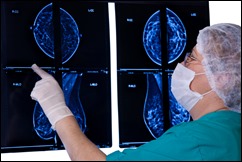Nearly 50% of women who undergo screening mammography are classified as having either heterogeneously dense or extremely dense breast tissue. Dense breast tissue is defined as a greater amount of fibrous or glandular tissue than fatty tissue in the breasts. Women with dense breast tissue have a modestly elevated risk for breast cancer and the sensitivity of screening mammography is reduced. One 2007 report states a four to five fold increased likelihood of developing breast cancer in women with dense breast versus women with low breast density. [i] Due to this data, and some assertive women’s health scientists and activists, certain states now require that women found to have dense breast tissue on screening mammography be provided a letter informing them of these findings and are then encouraged to follow up with their primary care provider to discuss risk and screening guidelines. While this is dictated by at least 11 state jurisdictions, and more to come, most physicians have yet to urge patients to get further testing. Even the American College of Obstetrics and Gynecologists (ACOG) is currently not offering guidelines to physicians, for further testing when the mammogram detects heterogeneously dense or extremely dense (grade 3 and 4 density respectively).
In a recent evidence based review, ACOG noted that “the assessment of breast  density is subjective and affected by the perspective of individual radiologists.”[ii] Their statement also indicates that “use of supplemental imaging such as ultrasound, magnetic resonance imaging (MRI), tomosynthesis, or thermography has not been associated with meaningful benefits for women found at screening to dense breasts.” They support further research on the topics but as of this writing, ACOG does not recommend use of alternative tests for dense breast detected on screening mammography
density is subjective and affected by the perspective of individual radiologists.”[ii] Their statement also indicates that “use of supplemental imaging such as ultrasound, magnetic resonance imaging (MRI), tomosynthesis, or thermography has not been associated with meaningful benefits for women found at screening to dense breasts.” They support further research on the topics but as of this writing, ACOG does not recommend use of alternative tests for dense breast detected on screening mammography
Commentary
As a practicing clinician providing healthcare for women these last 30 years, I am currently recommending a more proactive approach and not waiting for guidelines from ACOG. I advise my patients to have additional imaging if they have heterogeneously dense or extremely dense breasts. If they have no other risk factors for breast cancer, I am likely to just recommend a screening breast ultrasound. If they also have other risk factors for breast cancer (ex/ first degree relative with breast cancer, obesity, an intake of greater than 7 alcohol drinks per week, history of estrogen/progestin for greater than 4 years), then I may consider an MRI, in consultation with the radiologist and a breast surgeon.
References
[i] Boyd, N.F., et al. (2007). Mammographic breast density and the risk and detection of breast cancer. N Engl J Med. 356(3):227-36.
[ii] Committee on Gynecologic Practice. Committee Opinion No. 593: Management of women with dense breasts diagnosed by mammography. Obstet Gynecol 2014 Apr; 123:910

